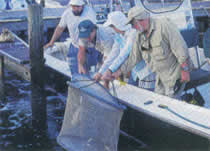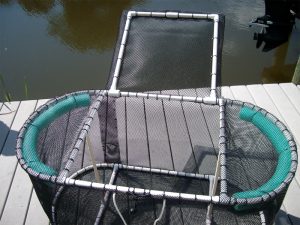July 10, 2012
By Eden White
Tournament season is here, and now's the time to think about storing baits for the long run.

Bait pens range from collapsible mesh (shown here) to custom-built, rigid plastic models. |
Like it or not, bluewater fishing has become quite competitive. Be it a big-money tournament or for just plain bragging rights in a friendly rivalry, there's always going to be somebody trying a little harder. One thing you can bank on in such an individual's arsenal is a good bait pen.
Unlike bait wells, which are normally integral parts of the boat, bait pens are mesh enclosures placed in the water, often for extended periods of time. Not only does this reduce wear and tear on onboard livewell pumps, batteries, and accessories, it helps prevent disaster should some component in the system fail. And while these enclosures come in various shapes, sizes and materials, they all serve the same basic need. However, there are still numerous factors to consider when it comes to choosing one for yourself, regardless if it is your first or your fifth.
Perhaps the biggest considerations are the kind and number of baits to be stored and for what duration. Also, those without ties to any certain marina or dock space must find somewhere secure to keep a bait pen. In some areas, even protection of the contents from predators and thievery can't be overlooked either. Ordinarily this comes in the form of otters, eels and barracudas, which often have no problem tearing through nylon mesh. Unfortunately, it can also come in the form of two-legged predators, particularly when demand is extraordinarily high for some reason. How the bait is handled is another factor.
Why go through the bother? For one thing, buying live bait is expensive and catching it is time consuming. Any time you can work around either of these things is beneficial. Besides that, during periods of peak demand, like in the midst of a hot sailfish bite or a big tournament, bait prices can be so exorbitant or availability so scarce that if you haven't stocked up before the rush, you'll be just plain out of luck.
Besides that, it never seems to fail that the day of the tournament the seas turn rough. This can alter patterns to the point where even if you are proficient at catching bait in such circumstances, they just may have temporarily turned off or moved. Those with a banked supply already on hand in this case are the ones with the supreme advantage and it will likely tell on the results board at day's end.
Selecting the perfect bait pen for your application depends also on how much you plan on using it. For example, if you have a slip in a marina and plan on keeping the pen permanently in the water, logic would dictate that you choose one that was more durable than, say, one needed for that annual outing to the Keys. This would also be true of areas where predators are likely, since that demands tougher measures altogether.
Water quality must also be examined. Keep in mind that the baits to be kept here are of the bluewater variety. Now that may include pilchards and other whitebaits which are caught inside (including mullet), but I'm still also referring mainly to frequently used species like goggle-eyes, rainbow runners, tinker mackerel and blue runners. What that means is if you have the option of choosing a site closer to the inlet as opposed to one that is well inland, definitely go for the former. Also, if say, you are in town for a tournament and there is some leeway in your slip assignment possibilities, try and learn the lay of the marina and determine if there are other options if water quality is poor there. For example, if one spot is right next to the fuel dock and offers minimal flushing while the other is distal to open and moving water, the one with better current could have a decided disadvantage.
Anyway, once these logistical problems are dealt with, you can decide which style pen is right for you. One thing to consider is storage. Since some designs are collapsible and others are rigid, you might have to worry about having a place to keep it. If that is a concern, then I would definitely take a hard look at the nylon models first. These come in a variety of sizes, ranging from a foot or so in diameter all the way to five feet, with the more useful sizes beginning at 24 inches. I've seen them in white and black models, but I don't know that there is advantage of one over the other.
The smallest sizes of these typically have a drawstring to close off the opening at the top, but anything larger features a latched lid. Besides the increased capacity, these are better because it's easier to get bait into and out of the pen in a hurry. Also, you don't have to worry about tying the knot so tightly that it won't come undone, or so loosely that the baits will all escape.
In any case, make sure you choose one made of non-corrosive materials with the bottom ring weighted while the upper floats. This allows the pen to maintain its shape even in a swift current. The soft, 1--4-inch mesh netting allows the unit to collapse to a 4-inch height for storage. Rinse it off and let it dry before you do so to minimize odors and help it last.
If the plan is to harbor just a few odd pilchards remaining from the day before, a 2-foot wide pen will do fine. But if the intent is to store enough for a full day's fishing, that won't do at all. In that case, I would opt for the largest one my budget would allow. Understand that these things aren't exactly cheap. Even a 24-incher will command around 70 bucks, while one that's three feet around and sports a 130-gallon capacity goes for around $90. However, many is the time when I've been able to keep a dozen or more leftover baits for the next day thanks to having one at hand. They might not be as good as baits caught the day of the fishing, but they sure do the job.

For heavy-duty or more permanent use, I would save the collapsible pens for other applications and instead opt for a more rigid one. One option here is to take a white industrial garbage can with a lid. Another is to buy a standard, heavy-walled polyethylene baitwell. Significantly more expensive than the soft models, it will last a lifetime. These tanks require of course that you drill them with lots and lots of holes, so many in fact that the finished product will look more like a sieve than a container. Keep in mind that if you start your openings six inches or so off the bottom, it will allow enough water to remain in the pen that the baits won't be bruised should it have to be temporarily removed from the water for any reason. If you choose to go this route, you'll have to supply some form of flotation, unless of course, you prefer that it stay completely submerged for security. Just make sure you keep it from navigable areas if you do.
What I do is take some large pieces of styrofoam and cut them to fit around the tank, but round buoy markers fixed on a line will look more official. Be certain that they are po
sitioned so that the tank floats evenly.
By far, you'll know you've graduated to the next level when you start to consider the next option: metal cages. Though I have known people who whipped together some coated chicken wire and an assortment of 1 x 2s, probably the best choice here is to buy one that is preassembled. Not only will it last longer, it will probably be significantly lighter than one you would build yourself.
Many of these, especially commercial versions, are kept completely submerged. I've seen some that were so heavy they required a winch to retrieve. These are placed beneath the surface not so much to prevent a hazard to navigation as to protect the contents. That much bait represents a lot of inventory and it's far from unheard of to come to the dock for a day of fishing only to find that someone has already helped himself. It never hurts to buy a lock.
How long can baits be expected to last in such a system? Goggle-eyes and runners have been known to survive for weeks on end provided that some sort of food source is supplied and they are handled properly. Often this will be little more than a bonito carcass lying on the bottom of the cage, but cut up chunks are even better. If you must touch the baits, use gloves and be gentle. Wipe off their protective coating of slime and sores will rapidly develop. Soon, they'll be dead on the bottom of the cage.
Bait pens aren't a necessity unless you are a professional. But if you like to fish with live bait and want to rest assured you'll have it when you need it, they're the only way to go--regardless if it's for big money or just plain bragging rights.
FS
Florida Sportsman Classics, August, 2001
